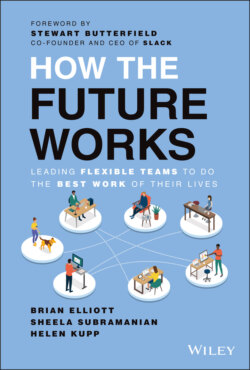Читать книгу How the Future Works - Brian Elliott - Страница 22
The How: Flexibility within a Framework
ОглавлениеDigital-First does mean giving your people the freedom and autonomy to do their best work from a place and on a schedule that best suits their needs, but the idea of employee freedom can scare off some leaders. That is, until they understand that flexible work isn't about total freedom or unstructured chaos. That's not something employers would be willing to give, but it's also not what workers are really asking for. While most don't want to be in the office from 9:00 a.m. to 5:00 p.m. (or worse, 8:00 a.m. to 8:00 p.m.) five days a week, they still want some structure in their workday. In fact, nearly two-thirds (65.6%) said they want a balance between full flexibility and a predictable framework.
What businesses need in order to be successful is to create what we call flexibility within a framework to support their Digital-First work model. They don't realize that for flexible work to really work, it requires much more than just a policy statement. It requires a significant change in your company culture, processes, and infrastructure. Too often companies miss the bigger picture and the larger opportunity.
That could have been true for Dropbox. Their leadership team was on board with the concept of location flexibility in the beginning, but there was hesitation about schedule flexibility and what that would mean in terms of collaboration among their people. The pandemic forced them to experiment, and the company found something that worked. (They call theirs “virtual first,” but it's a good example of a Digital-First strategy.) Then they created a framework of policies, tools, and infrastructure to support it.
Dropbox took a big bet on something that was untested and unfamiliar to them. It required significant changes and investment, but the improvements they've seen in recruitment, onboarding, and diversity speak for themselves. And that's just the beginning for them. As they continue to experiment and adjust to what works, they are sure to see more of the benefits that flexible work can bring, providing them with a real competitive advantage.
This is where the next part of this book comes in. You don't have to take a big bet on something that's completely untested. Through Future Forum's original research and work with companies that are paving the way, we have distilled what companies need to do to make the switch to Digital-First into seven key steps that will get you there. They will help you reimagine how the future works, and then design a framework that supports your new vision and drives results. It's not a quick-and-easy process, but as you saw with Dropbox—and as you will see with the many other company examples in this book—it's well worth it.
